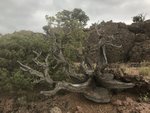amatbrewer
Shohin
While hiking in the mountains this weekend and observing trees for inspiration, I was struck by something that maybe someone could help explain.
I was focusing on sub-alpine firs (I love sub-alpine firs) and noticed most of the young trees had lots of really nice movement to the trunk (and most of the ones that were not 'nice' still had lots of movement). But then when I looked for examples of what this looks like as mature trees in the same area, I was surprised to find that it was hard if not almost impossible to find mature trees that I could envision starting as those same young ones?!?! Most of the mature trees had very little moment to the trunks and the few that did were not all that pleasing and most were from obvious causes (e.g. a large down hill bow near the base from rock or heavy snow loading on the hill).
Now I am familiar with the dramatic shapes I see in these when they are on ridge tops or cliff faces. How they get to become what they are is obvious from the extreme conditions they experience. But I am not sure how in the less extreme areas, why most of the young trees would have such dramatic (and often very pleasing to the eye) movement in the trunk, but it is almost nonexistent in the mature trees.
What am I missing?
Fop reference below is a young stand of sub-alpine firs that I found inspirational.

I was focusing on sub-alpine firs (I love sub-alpine firs) and noticed most of the young trees had lots of really nice movement to the trunk (and most of the ones that were not 'nice' still had lots of movement). But then when I looked for examples of what this looks like as mature trees in the same area, I was surprised to find that it was hard if not almost impossible to find mature trees that I could envision starting as those same young ones?!?! Most of the mature trees had very little moment to the trunks and the few that did were not all that pleasing and most were from obvious causes (e.g. a large down hill bow near the base from rock or heavy snow loading on the hill).
Now I am familiar with the dramatic shapes I see in these when they are on ridge tops or cliff faces. How they get to become what they are is obvious from the extreme conditions they experience. But I am not sure how in the less extreme areas, why most of the young trees would have such dramatic (and often very pleasing to the eye) movement in the trunk, but it is almost nonexistent in the mature trees.
What am I missing?
Fop reference below is a young stand of sub-alpine firs that I found inspirational.






